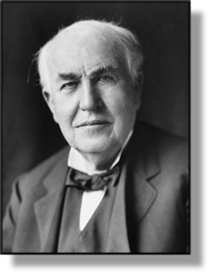 xxxxxThe first public
demonstration of motion pictures was given in 1891 by the company
owned by Thomas Alva Edison - the American inventor who, as
we have seen, produced the phonograph in 1877
(Vb), and the electric light bulb two
years later. The birth of the cinema and a worldwide film industry
were just four years distant.
xxxxxThe first public
demonstration of motion pictures was given in 1891 by the company
owned by Thomas Alva Edison - the American inventor who, as
we have seen, produced the phonograph in 1877
(Vb), and the electric light bulb two
years later. The birth of the cinema and a worldwide film industry
were just four years distant.
xxxxxItxwas in 1888, following his move to West Orange, New
Jersey, and the building of a large research laboratory there,
that Edison became interested in the idea of making moving
pictures. In October of that year he took out a patent describing
a device that would record and reproduce images in motion and “do
for the eye what a phonograph does for the ear”. Edison’s basic
work on the electro-mechanical design for this apparatus
started the project off, but it was his chief engineer, a young
Scotsman named William Dickson (1860-1935), who was tasked with and achieved
the required photographic and optical development. Together with a
number of assistants, he invented both the Kinetograph - a
camera capable of taking a series of instantaneous photographs -
and then the Kinetoscope, a peep show apparatus which enabled one
person at a time to view a rapid succession of individual views.
xxxxxThe first
showing of this peep-hole viewer, housed in a wooden cabinet,
was given in May 1891 for some 150
members of the National Federation of Women’s Clubs, especially
invited to the laboratory. The film was just three seconds long
and simply showed Dickson waving and taking off his hat, but it
made cinema history. The machine was then made coin-operated,
and was ready for production by the autumn of 1892. In May 1893 the Kinetoscope was given
its first public demonstration at the Brooklyn Institute of Arts
and Sciences. Among the first series of short films was a 5-second
sequence of a sneeze (made by Fred Ott, one of Dickson’s
assistants), and a movie showing three blacksmiths at work, about
34 seconds long. These and later films were made by Dickson and
his team in a specially constructed studio at West Orange which,
shrouded as it was in paper covered in black tar, came to be
called the “Black Maria” (the name given to a police wagon). The
studio was officially known as The Kinetographic Theatre, but
Edison dubbed it “the Dog House”.
 xxxxxThese movies aroused such interest that in April 1894
Edison opened the first Kinetoscope Parlour in Broadway, New York,
where for 25 cents different films could be viewed on a number of
machines. It proved immensely popular. Soon parlours were opened
in the major cities, and peep-show machines were installed in
amusement arcades and hotel lobbies across the United States. The
programmes included cock fights, wrestling, boxing matches,
trapeze artists, music hall performers, dancing displays and
everyday events. Not surprisingly, by the end of the year hundreds
of Kinetoscopes had been sent across the Atlantic. There they
quickly became a popular attraction in London, Paris and other
cities across Europe.
xxxxxThese movies aroused such interest that in April 1894
Edison opened the first Kinetoscope Parlour in Broadway, New York,
where for 25 cents different films could be viewed on a number of
machines. It proved immensely popular. Soon parlours were opened
in the major cities, and peep-show machines were installed in
amusement arcades and hotel lobbies across the United States. The
programmes included cock fights, wrestling, boxing matches,
trapeze artists, music hall performers, dancing displays and
everyday events. Not surprisingly, by the end of the year hundreds
of Kinetoscopes had been sent across the Atlantic. There they
quickly became a popular attraction in London, Paris and other
cities across Europe.
xxxxxFollowing
the widespread success of the Kinetoscope, Edison turned his
attention to a movie system with sound attached. By the Spring of
1895 he and Dickson had produced the Kinetophone - a
Kinetoscope with a phonograph fitted inside the cabinet - but
this often failed to synchronize sight with sound.
At this stage Edison was advised by members of his staff to turn
his attention to film projection, but he argued that the peep show
machines were selling well and that the development of a screen
would “kill the goose that lays the golden egg”. As a result, by
the time he came round to investigate a projection system one was
already in operation. As we shall see, in 1895 two French brothers, Louis and Auguste Lumière,
having seen Edison’s Kinetoscope working in Paris, developed the
means of projecting moving pictures onto a screen and opened the
world’s first cinema.
xxxxxEventually,
having seen his sales of the Kinetoscope plummet, Edison decided
to invest in a 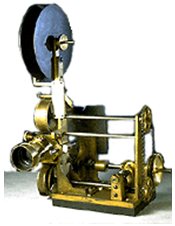 projection
system. He acquired a projector developed by two young American
inventors named Charles Frances Jenkins (1867-1934) and Thomas
Armat (1866-1948), and introduced
it as his latest machine, the Vitascope (illustrated). (Later used to take movies of the Second Anglo-Boer War). In November 1896,
however, his laboratory came up with the Projectoscope, an improved
projector, and this gave him a place - eventually quite
extensive - in the cinema business. In 1908 he started the
Motion Picture Patents Company, a conglomerate of nine film studios,
and in 1912 he marketed an ingenious but fairly expensive Home
Projecting Kinetoscope. In the meantime, he returned to the question
of sound. By 1913 he had produced a prototype, but once again the
task of synchronizing sight and sound by using a complicated
arrangement of pulleys proved too difficult. Reluctant to replace
the cylinder with the disc, he abandoned the scheme within a year.
It was not, in fact, until 1926 that an improved sound-on-disc
system gave birth to the “talkies”.
projection
system. He acquired a projector developed by two young American
inventors named Charles Frances Jenkins (1867-1934) and Thomas
Armat (1866-1948), and introduced
it as his latest machine, the Vitascope (illustrated). (Later used to take movies of the Second Anglo-Boer War). In November 1896,
however, his laboratory came up with the Projectoscope, an improved
projector, and this gave him a place - eventually quite
extensive - in the cinema business. In 1908 he started the
Motion Picture Patents Company, a conglomerate of nine film studios,
and in 1912 he marketed an ingenious but fairly expensive Home
Projecting Kinetoscope. In the meantime, he returned to the question
of sound. By 1913 he had produced a prototype, but once again the
task of synchronizing sight and sound by using a complicated
arrangement of pulleys proved too difficult. Reluctant to replace
the cylinder with the disc, he abandoned the scheme within a year.
It was not, in fact, until 1926 that an improved sound-on-disc
system gave birth to the “talkies”.
xxxxxOther
projects at this time were more successful. In 1896 he designed a
Fluoroscope, an X-ray machine which, by the use of calcium
tungstate, greatly improved the quality of the screen originally
invented by Wilhelm Roentgen. There followed in 1901 his alkaline
storage battery, one of his most lucrative inventions. Produced
after extensive research, by 1909 he was the principal supplier of
batteries. These met a wide variety of needs, including train
lighting and signalling, lighting in submarines, and the powering
of mining lamps and the new automobiles. And it was at this time
that, as a friend of the automobile magnate Henry Ford (1863-1947)
- who lived near to his winter retreat in Florida - he
contributed to the development of the first motor cars.
xxxxxHe had one
long-term failure. Throughout the 1880s and much of the1890s
his laboratory worked on a means of extracting iron from discarded
low-grade ores by means of a magnetic ore-separator. In
the course of this research he acquired no less than 145 old
mines, but he never overcome the engineering problems involved,
and this proved a costly undertaking. But this failure cannot in
anyway detract from the genius of Thomas Alva Edison. By his own
ingenuity, persistence and determination - or by his guidance
of others in pursuance of his aims - he produced a series of
inventions which improved the quality of life for millions of
people and did much to shape modern society - be it the
phonograph, the electric light bulb, the first moving pictures or,
perhaps above all, a generating system designed for the
distribution of electricity.
xxxxxAnd he also
enhanced the inventions of others, improving, for example, the
efficiency of the storage battery and the quality of both Bell’s
telephone and Roentgen’s X-ray screen. His Congressional Gold
Medal, awarded in 1928 (just one of the many honours bestowed upon
him), referred to his “development and application of inventions
that have revolutionized civilization”. Few men can lay claim to
such a distinction.
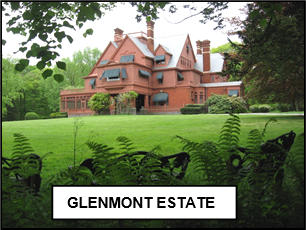 xxxxxBy the beginning of the 20th century Edison was a
very wealthy and a very famous man. Regarded as an eccentric
genius (an image he cultivated), he was a folk hero and a legend
in his own time. As a man who rose from rags to riches he was the
epitome of the “American Dream”, but in his private life he was
very much a loner, perhaps caused in part by the fact that he had
been partially deaf for most of his life. In the late 1920s his
health deteriorated and he died of complications caused by
diabetes in October 1931. He was buried behind his mansion,
Glenmont, in West Orange, New Jersey (illustrated). On the night of his funeral many people turned off
their lights for one minute to honour the Wizard of Menlo, the man
who had lit up the world. The house where he was born in Milan,
Ohio, is now the Edison Birthplace Museum, and there is the Thomas
Ava Edison Memorial and Museum in the town of Edison, New Jersey.
xxxxxBy the beginning of the 20th century Edison was a
very wealthy and a very famous man. Regarded as an eccentric
genius (an image he cultivated), he was a folk hero and a legend
in his own time. As a man who rose from rags to riches he was the
epitome of the “American Dream”, but in his private life he was
very much a loner, perhaps caused in part by the fact that he had
been partially deaf for most of his life. In the late 1920s his
health deteriorated and he died of complications caused by
diabetes in October 1931. He was buried behind his mansion,
Glenmont, in West Orange, New Jersey (illustrated). On the night of his funeral many people turned off
their lights for one minute to honour the Wizard of Menlo, the man
who had lit up the world. The house where he was born in Milan,
Ohio, is now the Edison Birthplace Museum, and there is the Thomas
Ava Edison Memorial and Museum in the town of Edison, New Jersey.
xxxxxIncidentally, in 1876 Edison was visited at Menlo Park by the
Irish scientist Sir William Thomson (later Lord Kelvin). Apart
from Henry Ford, Edison numbered among his acquaintances the
French physicist Marie Curie, President Herbert Hoover, and
Charles Lindbergh, the American aviator who made the first
transatlantic flight in 1927. ……
xxxxx……xxWhen told on one occasion
that, in the course of his research, thousands of his experiments
had failed, Edison replied that they were not failures, they had
served to tell him what things wouldn’t work! ……
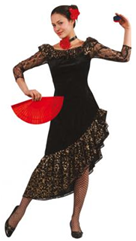 xxxxx……xxEdison
married Mary Stilwell, a sixteen-year-old who worked in
one of his shops, in December 1871 and, following her death in
1884, he married Mina Miller, the daughter of an inventor, two
years later. He had three children from both marriages. It is said
that he taught Mina the Morse code and proposed to her by tapping
a message out on her hand! ……
xxxxx……xxEdison
married Mary Stilwell, a sixteen-year-old who worked in
one of his shops, in December 1871 and, following her death in
1884, he married Mina Miller, the daughter of an inventor, two
years later. He had three children from both marriages. It is said
that he taught Mina the Morse code and proposed to her by tapping
a message out on her hand! ……
xxxxx……xxIn the summer of 1894 a
programme shown on a Kinetoscope, his peep-show invention, in
Asbury Park, New Jersey, led to the first film censorship in movie
history. A Spanish dance sequence was banned because it gave a
glimpse of the dancer’s “ankles and lace”! ……
xxxxx……xxEdison was deeply upset
in the late 1890s when, following his experiments to improve the
screen of Roentgen’s X-ray machine, one of his researchers
named Clarence Dally became an early victim to radiation. In an
attempt to save him, both his arms were eventually amputated, but
he died in 1904. Edison vowed never to work with X-rays
again.
 xxxxxBut the birth of motion pictures
cannot be put down to one man alone. Whilst Edison was one of the
foremost pioneers in this field - mainly through the ability
of his team of researchers at his laboratory at West Orange -
there were many inventors attempting to develop moving images at
this time, and a number took advantage of the discoveries of
others. As we have seen in 1888, for example, the American inventor George Eastman
made a considerable contribution to photography and, indirectly,
the development of motion pictures. His Kodak celluloid roll film,
which proved remarkably strong and pliable, was used by Dickson
from 1889 onwards. Without it, the Kinetoscope would not have
achieved such a measure of success.
xxxxxBut the birth of motion pictures
cannot be put down to one man alone. Whilst Edison was one of the
foremost pioneers in this field - mainly through the ability
of his team of researchers at his laboratory at West Orange -
there were many inventors attempting to develop moving images at
this time, and a number took advantage of the discoveries of
others. As we have seen in 1888, for example, the American inventor George Eastman
made a considerable contribution to photography and, indirectly,
the development of motion pictures. His Kodak celluloid roll film,
which proved remarkably strong and pliable, was used by Dickson
from 1889 onwards. Without it, the Kinetoscope would not have
achieved such a measure of success.
xxxxxAndxthere were many other advances, some of which failed
simply because of the lack of financial support. As early as 1877
the photographer Eadweard Muybridge (1830-1904), an Englishmen who spent most of
his life in the United States, began experimenting with a series
of photographs depicting a running horse, taken by a line of
twelve cameras. Later he perfected his Zoopraxiscope.
This created the illusion of movement by placing a series of
images of animals or people on a glass disc and turning the disc
passed the lens of a magic lantern. This idea inspired a French
physiologist named Étienne-Jules
Marey (1830-1904). In 1882 he
devised a “photographic gun” which, when “fired”, rotated a glass
plate and took twelve photographs a second of a bird in flight.
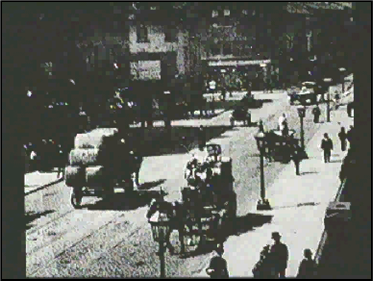
xxxxxThesexflickering attempts were poor at best, but in 1888 a French photographer named Louis
Le Prince (1842-1890), using a
single lens camera and paper film, took a sequence of moving
pictures showing traffic going over a bridge in the English city
of Leeds (illustrated). He is regarded
by many as the first filmmaker but, unfortunately, his research was
cut short. He planned to give a public demonstration on a visit to
the United States, but he disappeared in mysterious circumstances
two years later. Likewise the English inventor William Friese-Green (1855-1921), must be seen as a leading pioneer in
photography rather than “the father of motion pictures”. It is said
that, using his own “chronophotographic” camera, capable of taking
short picture sequences on a roll of perforated film, he took the
first movie images, a scene showing people and horse-drawn
vehicles at Hyde Park Corner, London, in 1889. However, it appears
that the movement was very jerky - ten pictures a second
proving inadequate - and, again, he gave no successful
presentation of his achievement. The cost of his research eventually
led to bankruptcy in 1891.
xxxxxThexmajor break through, as we have seen, came with the
advent of celluloid film, produced and
marketed by Eastman in 1889. This replaced glass and metal plates
and was a major step forward in the advent of motion pictures.
Even in this respect, however, there were others who deserve
recognition. As early as the mid-1880s the English
photographer John Carbutt
(1832-1905), working in Philadelphia,
began using transparent celluloid strips
coated with a photosensitive gelatine emulsion. This, in fact,
proved too stiff for the needs of motion photography, but in May
1887, as we have seen, an American clergyman named Hannibal
Goodwin filed
a patent for a more flexible material, and some years later
Eastman was fined for the infringement of the copyright. Andxit was a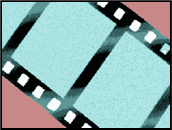 French science teacher,
Émile Reynaud
(1844-1918) who, on replacing glass plates with paper film
for his animated film show called Théatre
Optique, made holes in the centre of the film strip to
assist its passage. This perforation - later involving a
series of slots along both edges of the strip - was to be an
essential requirement when motion pictures came to be projected
onto a screen.
French science teacher,
Émile Reynaud
(1844-1918) who, on replacing glass plates with paper film
for his animated film show called Théatre
Optique, made holes in the centre of the film strip to
assist its passage. This perforation - later involving a
series of slots along both edges of the strip - was to be an
essential requirement when motion pictures came to be projected
onto a screen.
xxxxxThe birth
of the cinema eventually came in the mid-1890s. Today it is
generally accepted that it was the French brothers Louis and
Auguste Lumière, working
in Paris, who
opened the first cinema in December 1895. But, as we shall see, that assumption did not go
unchallenged.
xxxxxIncidentally, in Leeds, Le Prince’s achievement has not been
forgotten. A bronze memorial tablet, unveiled in 1930, is on
display at his one-time workshop in Woodhouse Lane.



 xxxxxThe first public
demonstration of motion pictures was given in 1891 by the company
owned by Thomas Alva Edison -
xxxxxThe first public
demonstration of motion pictures was given in 1891 by the company
owned by Thomas Alva Edison - xxxxxThese movies aroused such interest that in April 1894
Edison opened the first Kinetoscope Parlour in Broadway, New York,
where for 25 cents different films could be viewed on a number of
machines. It proved immensely popular. Soon parlours were opened
in the major cities, and peep-
xxxxxThese movies aroused such interest that in April 1894
Edison opened the first Kinetoscope Parlour in Broadway, New York,
where for 25 cents different films could be viewed on a number of
machines. It proved immensely popular. Soon parlours were opened
in the major cities, and peep- projection
system. He acquired a projector developed by two young American
inventors named Charles Frances Jenkins (1867-
projection
system. He acquired a projector developed by two young American
inventors named Charles Frances Jenkins (1867- xxxxxBy the beginning of the 20th century Edison was a
very wealthy and a very famous man. Regarded as an eccentric
genius (an image he cultivated), he was a folk hero and a legend
in his own time. As a man who rose from rags to riches he was the
epitome of the “American Dream”, but in his private life he was
very much a loner, perhaps caused in part by the fact that he had
been partially deaf for most of his life. In the late 1920s his
health deteriorated and he died of complications caused by
diabetes in October 1931. He was buried behind his mansion,
Glenmont, in West Orange, New Jersey (illustrated). On the night of his funeral many people turned off
their lights for one minute to honour the Wizard of Menlo, the man
who had lit up the world. The house where he was born in Milan,
Ohio, is now the Edison Birthplace Museum, and there is the Thomas
Ava Edison Memorial and Museum in the town of Edison, New Jersey.
xxxxxBy the beginning of the 20th century Edison was a
very wealthy and a very famous man. Regarded as an eccentric
genius (an image he cultivated), he was a folk hero and a legend
in his own time. As a man who rose from rags to riches he was the
epitome of the “American Dream”, but in his private life he was
very much a loner, perhaps caused in part by the fact that he had
been partially deaf for most of his life. In the late 1920s his
health deteriorated and he died of complications caused by
diabetes in October 1931. He was buried behind his mansion,
Glenmont, in West Orange, New Jersey (illustrated). On the night of his funeral many people turned off
their lights for one minute to honour the Wizard of Menlo, the man
who had lit up the world. The house where he was born in Milan,
Ohio, is now the Edison Birthplace Museum, and there is the Thomas
Ava Edison Memorial and Museum in the town of Edison, New Jersey. xxxxx……xxEdison
married Mary Stilwell, a sixteen-
xxxxx……xxEdison
married Mary Stilwell, a sixteen- xxxxxBut the birth of motion pictures
cannot be put down to one man alone. Whilst Edison was one of the
foremost pioneers in this field -
xxxxxBut the birth of motion pictures
cannot be put down to one man alone. Whilst Edison was one of the
foremost pioneers in this field -
 French science teacher,
Émile Reynaud
(1844-
French science teacher,
Émile Reynaud
(1844-


